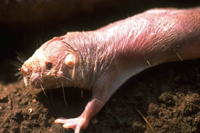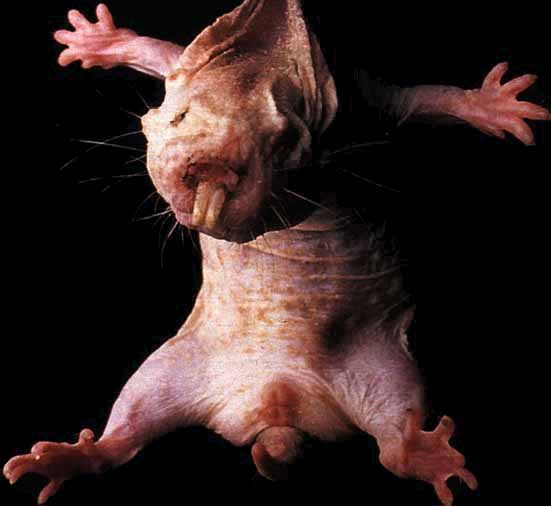 Eusociality in Naked Mole-Rats
Eusociality in Naked Mole-Rats
Biology 342 - Fall 2010
Isabel Cylinder & Quinn Amacher
Adaptive Value
What is Adaptive Value?
Adaptive value can perhaps best be described as the quality of a trait or behavior that most benefits the organism from a Darwinian perspective: why is eusociality the most efficient way for naked mole-rats to survive and perpetuate their genetic material (1)? Certainly there are disadvantages to eusociality. Inbreeding, generally avoided due to its ability to perpetuate potentially deleterious genes, is a natural consequence of the reproductive distribution of labor displayed by the mole-rats, and, though naked mole-rats do not appear to suffer the negative effects of such behavior (8), it has been suggested that inbreeding was selected in the mole-rats not because of its benefits but because of the benefits provided by the colony-organization which necessitates inbreeding (7). What, then, are the evolutionary advantages of eusocial behavior to the naked mole-rat? Several theories have been developed.
Aridity Food-Distribution Hypothesis

As its name suggests, the aridity food-distribution hypothesis (AFDH) draws a direct correlation between the low rainfall of the naked mole-rat’s natural environment and the animal’s preference for large colony size and reproductive division of labor. Aridity presents two main obstacles to solitary behavior. Firstly, dry soil is significantly harder to burrow through than wet soil, meaning that the cost of burrowing, and therefore of dispersal, is increased for mole-rats in arid environments. Secondly, the food resources available to mole-rats in arid environments usually take the form of geophytes, the roots and tubers of arid-adapted plants, which tend to be more sparsely-distributed than they would in areas of greater rainfall. This results in a higher risk of unsuccessful foraging. Due to these conditions, the theory concludes, group living and group foraging will be selectively favored for mole-rats in arid environments (2,10).
Since its conception, the theory has found support in numerous studies. One survey of common mole-rat populations at both mesic and arid sites showed a greater stability in the size of colonies at the latter sites, suggesting the cost of dispersal to be higher in arid regions (24). Another survey of various African mole-rat species revealed a negative correlation between maximum group size and geophyte density, suggesting group foraging to be an adaptation to sparse distribution of food (10).
Despite this evidence, however, the AFDH is not without its detractors (2,3,4). In his April, 2000 article, “Are naked and common mole-rats eusocial and if so, why,” author Hynek Burda asserts that the AFDH, while it explains colony size, fails to explain the division of reproductive labor displayed by the naked mole-rats. If the only pressures being applied to naked mole-rats in arid environments are towards group living and group foraging, why do they delegate all reproduction to a single queen?
Pictured: A naked mole-rat with limbs splayed. (I)
Risk-Sensitive Metabolism and The Work-Conflict Hypothesis
.jpg)
In a pair of papers released in the late 1980s, B.C. Lovegrove examined the energetic costs of group foraging as they relate to the structure of naked mole-rat colonies (15,17). In the first, Lovegrove used a mathematic model to show that the benefit of group foraging was not that it procured more resources but that it reduced the risk of procuring none. Here, he observed that, in order to support the presence of non-workers within a colony, the total energy expenditure of the colony would have to be reduced, perhaps by a reduction in the body weight of the foragers.
In his second paper, reversed this proposed chain of cause and effect. Examining the metabolic costs of burrowing in wet and dry sand, Lovegrove showed that burrowing efficiency is increased with smaller body size. From this, he hypothesized that the energy saved by a group of small foragers could be used to support several larger non-working “soldiers,” as well as a non-working queen.
A 1996 paper by Jarvis (11) further examined this division between body size and social role, particularly in the interactions between the queens and larger non-breeders. Here, she determined that these larger non-breeders, targets of most of the queen’s aggression, worked significantly less than smaller members of the colony. Her explanation for this “laziness” was that, as members of the colony grow larger, their chances to eventually breed grow as well, therefore providing them with less of an incentive to aid the queen in the perpetuation of her genetic material. Seen in this way, naked mole-rat colonies become a hive of conflicting Darwinian motivations, a world where an individual’s role is defined by her slowly-changing chances of reproduction.
Pictured: H. glaber in burrow. (J)